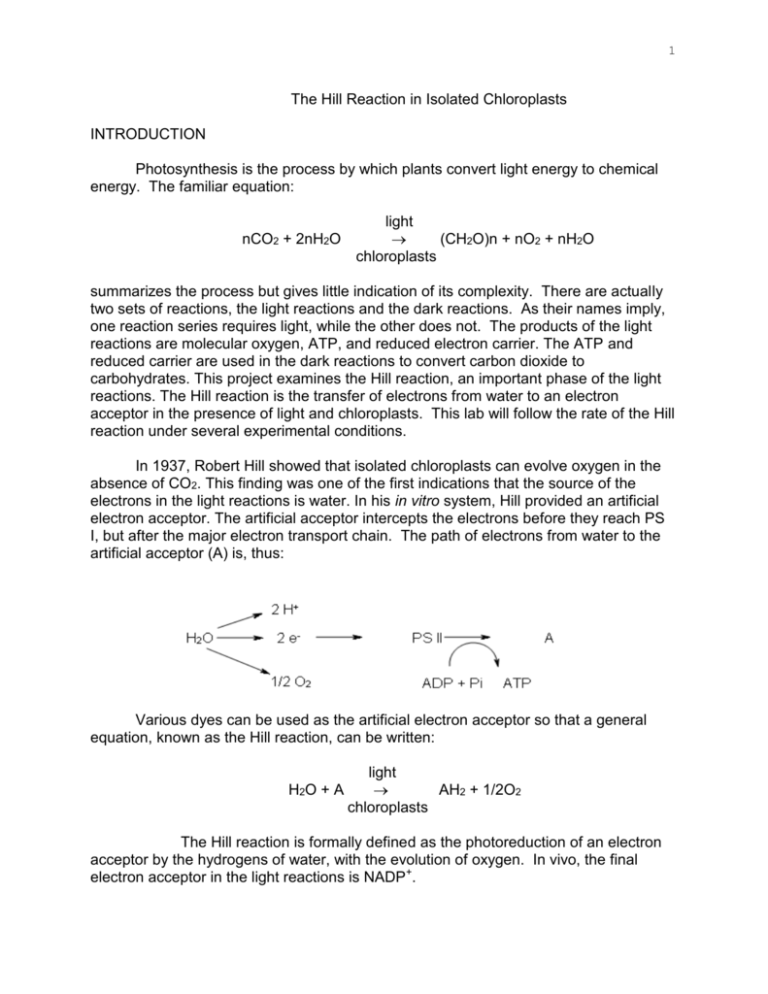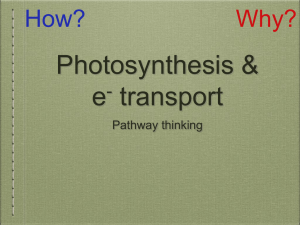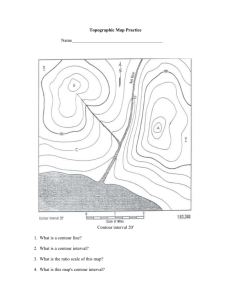The Hill Reaction in Isolated Chloroplasts
advertisement

1 The Hill Reaction in Isolated Chloroplasts INTRODUCTION Photosynthesis is the process by which plants convert light energy to chemical energy. The familiar equation: nCO2 + 2nH2O light (CH2O)n + nO2 + nH2O chloroplasts summarizes the process but gives little indication of its complexity. There are actually two sets of reactions, the light reactions and the dark reactions. As their names imply, one reaction series requires light, while the other does not. The products of the light reactions are molecular oxygen, ATP, and reduced electron carrier. The ATP and reduced carrier are used in the dark reactions to convert carbon dioxide to carbohydrates. This project examines the Hill reaction, an important phase of the light reactions. The Hill reaction is the transfer of electrons from water to an electron acceptor in the presence of light and chloroplasts. This lab will follow the rate of the Hill reaction under several experimental conditions. In 1937, Robert Hill showed that isolated chloroplasts can evolve oxygen in the absence of CO2. This finding was one of the first indications that the source of the electrons in the light reactions is water. In his in vitro system, Hill provided an artificial electron acceptor. The artificial acceptor intercepts the electrons before they reach PS I, but after the major electron transport chain. The path of electrons from water to the artificial acceptor (A) is, thus: Various dyes can be used as the artificial electron acceptor so that a general equation, known as the Hill reaction, can be written: H2O + A light AH2 + 1/2O2 chloroplasts The Hill reaction is formally defined as the photoreduction of an electron acceptor by the hydrogens of water, with the evolution of oxygen. In vivo, the final electron acceptor in the light reactions is NADP+. 2 In isolated chloroplasts, a convenient method for measuring the rate of the Hill reaction is to use as the artificial electron acceptor a dye that changes color as it is reduced. We will use the dye 2,6-dichlorophenolindophenol (DCIP), which is blue in its oxidized form and colorless in its reduced form. The change in absorbance, which is measured at 600 nm, will be used to measure the rate of the Hill reaction under a variety of conditions in two experiments. Experiment 1: Effect of Inhibitor on the Hill Reaction In the first experiment, the normal rate of the Hill reaction will be measured and compared to the rate in the presence of an inhibitor. The inhibitor is 3-(3,4 dichlorophenyl)-1, 1-dimethylurea (DCMU), an herbicide. DCMU blocks both electron transport and phosphorylation by interrupting electron flow at the beginning of the major electron transport chain. The control in Experiment 1 is a reaction mixture kept in the dark. Experiment 2: Effect of Light Intensity on the Hill Reaction In the second experiment, which you will design yourself, you will determine the effect of light intensity on the rate of the Hill reaction. You should vary the light intensity by placing the reaction vessel at different distances from the light source. Keep in mind that light intensity decreases as the square of the distance from the source. Chloroplast Isolation The chloroplasts will be obtained from spinach leaves using a modification of a standard fractionation procedure (Whatley and Arnon, 1962). After homogenization in a mortar and pestle with a buffered, isotonic salt solution and a small quantity of sand, the suspension is centrifuged at 1400 RPM for 1 min. The brief centrifugation at low RCF sediments debris and whole cells. The supernatant is then spun at 3500 RPM for 10 min, sedimenting the chloroplasts (and nuclei). Examine the chloroplast fraction microscopically after Experiments 1 and 2 have been completed. Procedure 1. Weigh out 4g of fresh spinach leaves from which the major veins have been removed. 2. Cut the leaves into small pieces with scissors and then place in a chilled mortar (refrigerated) with 15 ml of ice-cold NaCl-buffer and a sprinkling of purified sand. Grind the tissue with a chilled pestle for 2 min. 3. Filter the suspension through 8 layers of cheesecloth and wring out the juice. The suspension can be filtered directly into a chilled 15-ml graduated, conical centrifuge tube. 3 4. Centrifuge the filtrate at 1500 RPM for 1 min. Make sure that the centrifuge tubes are balanced. 5. Decant the supernatant into a clean, chilled centrifuge tube and spin at 3500 RPM for 5 min. 6. Decant and discard the supernatant and then, with a Pasteur pipet, resuspend the pellet in 10 ml of ice-cold NaCl-buffer. 7. Transfer 4 ml of the chloroplast suspension to a clean, chilled test tube and dilute with 6 ml of ice-cold NaCl-buffer. Save the rest of the suspension. Invert the capped test tube several times and place in an ice-water bath. It is this diluted chloroplast suspension (hereafter referred to as chloroplast suspension) that will be used to measure the Hill reaction. Experiment 1: Effect of Inhibitor on the Hill Reaction 1. Allow the spectrophotometer to warm up for at least 5 min. Set the wavelength at 600 nm. 2. Prepare a water bath as follows. Add 150 ml of water at 20 oC to a 250 ml beaker. During illumination, the tubes (cuvettes) are kept in the water bath to keep the reaction temperature fairly constant. Adjust the temperature of the water bath at the beginning of each experimental trial. 3. Place the water bath 25 cm from a lamp with a 100-watt frosted incandescent bulb, but do not turn on the lamp until the start of each experimental trial. 4. Label 4 cuvettes as shown in the following table. Except for the ice-cold chloroplast suspension, all solutions should be at room temperature. Tube NaClbuffer* DCIP (4 x 10-4 M) Blank 1* 2 3 3.5 ml 3.5 ml 3.5 ml 3.0 ml --0.5 ml 0.5 ml 0.5 ml DCMU (2 x 10-4 M) ------0.5 ml Distilled water 0.5 ml ------- Chloroplast suspension* 1.0 ml 1.0 ml 1.0 ml 1.0 ml *Tube 1 will be wrapped with two layers of aluminum foil so that no light can enter. 5. Wrap Tube 1, the non-illuminated control, with two layers of aluminum foil and make a loose-fitting foil cap for the top of the cuvette. 6. Prepare the reference blank and Tube 1. Add the solutions in the sequence given across the top of the table, from left to right. Before and after adding the chloroplast suspension, which should be inverted several times just before it is added, cover each 4 cuvette with Parafilm and invert twice to mix the contents. Note the time and set Tube 1 aside. An absorbance reading should be taken after 10 min. Meanwhile, proceed with the steps below. 7. Adjust the spectrophotometer for the blank. 8. Prepare Tube 2. Add the solutions in the same manner used for Tube 1 in step 6. Immediately take the 0-min absorbance. 9. Immediately place Tube 2 in the water bath and then take an absorbance reading at a 1-min interval of illumination. Do this by quickly removing the tube from the water bath, wiping the surface of the cuvette, and measuring the absorbance. 10. Immediately return Tube 2 to the water bath and take absorbance reading at 1-min intervals of illumination up to 10 min. The spectrophotometer should be adjusted for the blank after every few readings. Remember to take the 10-min absorbance reading for Tube 1. 11. Prepare Tube 3, which contains the herbicide (DCMU). Add the solutions in the same manner used for Tube 1 in step 6. Take an absorbance reading immediately and then at 1-min intervals of illumination for 10 min. Remember to adjust the temperature of the water bath to 20oC at the outset and to adjust the spectrophotometer for the blank after every few readings. Experiment 2: Effect of Light Intensity on the Hill Reaction Carry out an experiment to measure the normal rate of the Hill Reaction at two different light intensities (12 cm and 50 cm from the lamp). Describe each of the tubes in your experiment, including the contents of each and the distance from the light source. Observations on the Chloroplast Fraction 1. With a Pasteur pipette, remove a drop of the chloroplast suspension and prepare a wet mount. 2. Examine under high-dry and oil-immersion. Describe the morphology of the chloroplasts, including their dimensions. Is the interior of the chloroplast homogenous? Explain. ANALYSIS AND QUESTIONS FOR DISCUSSION 1. Determine the change in absorbance (A) at each time interval, i.e., the difference between the initial absorbance at time O and the absorbance reading at each specified time. 5 2. Plot the rate of the Hill reaction for tubes with and without the DCMU (Experiment 1) on a single graph. Plot the change in absorbance (A) versus time. Include the origin as a point for all curves, i.e., the 0-min value for A is assumed to be 0. 3. In which tube in Experiment 1 does the reaction proceed most rapidly? Explain. 4. Explain the appearance of the curve for the tube with the herbicide. 5. Plot the rate of the Hill reaction for the tubes in Experiment 2 on a single graph. Plot the change in absorbance (A) versus time. Include the origin as a point for all curves, i.e., the 0-min value for A is assumed to be 0. Include the data for tube 2 in experiment 1 on this graph. Label each plot with the distance from the reaction vessel to the light source. 6. Discuss the relationship between the rate of the Hill reaction and the light intensity. Include in you discussion any possible sources of error in Experiment 2. 7. Discuss the location and significance of chloroplast reactions demonstrated in the in vitro Hill reaction.






